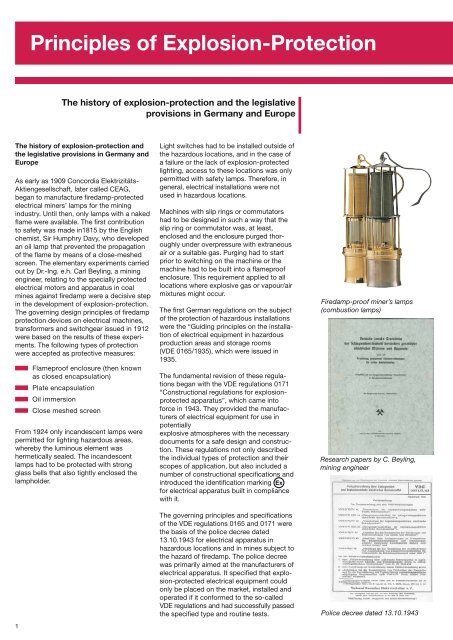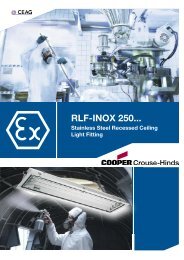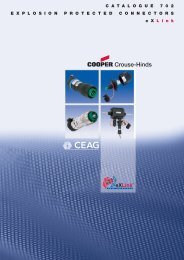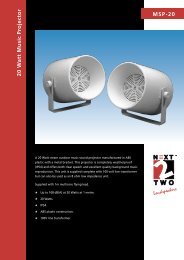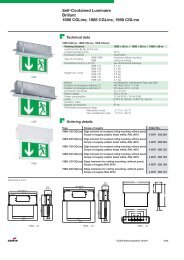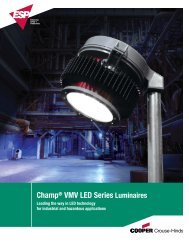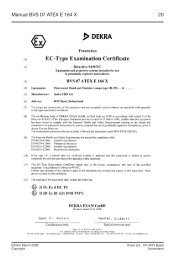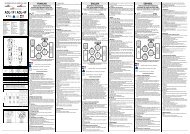Principles of Explosion-Protection
Principles of Explosion-Protection - Acasa | Intec Automatizari
Principles of Explosion-Protection - Acasa | Intec Automatizari
- No tags were found...
You also want an ePaper? Increase the reach of your titles
YUMPU automatically turns print PDFs into web optimized ePapers that Google loves.
<strong>Principles</strong> <strong>of</strong> <strong>Explosion</strong>-<strong>Protection</strong>The history <strong>of</strong> explosion-protection and the legislativeprovisions in Germany and EuropeThe history <strong>of</strong> explosion-protection andthe legislative provisions in Germany andEuropeAs early as 1909 Concordia Elektrizitäts-Aktiengesellschaft, later called CEAG,began to manufacture firedamp-protectedelectrical miners’ lamps for the miningindustry. Until then, only lamps with a nakedflame were available. The first contributionto safety was made in1815 by the Englishchemist, Sir Humphry Davy, who developedan oil lamp that prevented the propagation<strong>of</strong> the flame by means <strong>of</strong> a close-meshedscreen. The elementary experiments carriedout by Dr.-Ing. e.h. Carl Beyling, a miningengineer, relating to the specially protectedelectrical motors and apparatus in coalmines against firedamp were a decisive stepin the development <strong>of</strong> explosion-protection.The governing design principles <strong>of</strong> firedampprotection devices on electrical machines,transformers and switchgear issued in 1912were based on the results <strong>of</strong> these experiments.The following types <strong>of</strong> protectionwere accepted as protective measures:Flamepro<strong>of</strong> enclosure (then knownas closed encapsulation)Plate encapsulationOil immersionClose meshed screenFrom 1924 only incandescent lamps werepermitted for lighting hazardous areas,whereby the luminous element washermetically sealed. The incandescentlamps had to be protected with strongglass bells that also tightly enclosed thelampholder.1Light switches had to be installed outside <strong>of</strong>the hazardous locations, and in the case <strong>of</strong>a failure or the lack <strong>of</strong> explosion-protectedlighting, access to these locations was onlypermitted with safety lamps. Therefore, ingeneral, electrical installations were notused in hazardous locations.Machines with slip rings or commutatorshad to be designed in such a way that theslip ring or commutator was, at least,enclosed and the enclosure purged thoroughlyunder overpressure with extraneousair or a suitable gas. Purging had to startprior to switching on the machine or themachine had to be built into a flamepro<strong>of</strong>enclosure. This requirement applied to alllocations where explosive gas or vapour/airmixtures might occur.The first German regulations on the subject<strong>of</strong> the protection <strong>of</strong> hazardous installationswere the “Guiding principles on the installation<strong>of</strong> electrical equipment in hazardousproduction areas and storage rooms(VDE 0165/1935), which were issued in1935.The fundamental revision <strong>of</strong> these regulationsbegan with the VDE regulations 0171“Constructional regulations for explosionprotectedapparatus”, which came int<strong>of</strong>orce in 1943. They provided the manufacturers<strong>of</strong> electrical equipment for use inpotentiallyex plosive atmospheres with the necessarydo cu ments for a safe design and construction.These regulations not only describedthe in dividual types <strong>of</strong> protection and theirscopes <strong>of</strong> application, but also included anumber <strong>of</strong> constructional specifications andintroduced the identification marking Exfor electrical apparatus built in compliancewith it.The governing principles and specifications<strong>of</strong> the VDE regulations 0165 and 0171 werethe basis <strong>of</strong> the police decree dated13.10.1943 for electrical apparatus inhazardous locations and in mines subject tothe hazard <strong>of</strong> firedamp. The police decreewas primarily aimed at the manufacturers <strong>of</strong>electrical apparatus. It specified that explosion-protectedelectrical equipment couldonly be placed on the market, installed andoperated if it conformed to the so-calledVDE regulations and had successfully passedthe specified type and routine tests.Firedamp-pro<strong>of</strong> miner’s lamps(combustion lamps)Research papers by C. Beyling,mining engineerPolice decree dated 13.10.1943


